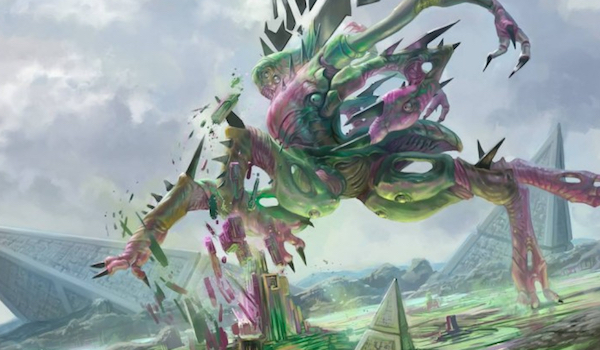Are you a Quiet Speculation member?
If not, now is a perfect time to join up! Our powerful tools, breaking-news analysis, and exclusive Discord channel will make sure you stay up to date and ahead of the curve.
Beaters, or combat creatures, are among my favorite types of Magic cards. They serve to pressure opponents in the most straightforward way possible: by attacking efficiently. Weaker beaters, such as Delver of Secrets, are at their best when paired with disruption; stronger ones can emerge later in the game to take over or put things away. One beater in particular has deeply altered the Modern landscape since rearing its ugly head.

In "Tough as Nails: Combat, Removal, and Stats," I slotted these creatures into different Stages depending on the part of the game they usually resolve. Today we'll go a step deeper, breaking down the biggest, baddest beaters in Modern.
Beating the Horse
A standby metric for these articles is power, which describes a spell's impact relative to its mana cost. But since beaters are just glorified stat vessels, I've split that metric into its two rightful parts.
- Bulk: The creature's power and toughness.
- Castability: The ease and speed with which decks tailored to do so can produce the creature.
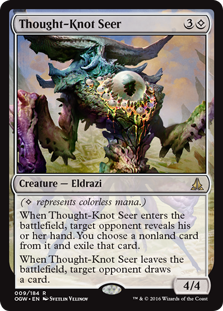 Omitted from these metrics is utility, a definite factor when it comes to certain beaters, such as Thought-Knot Seer. This call was made on the basis that beaters are rarely employed for their utility applications. For instance, Tron is the only non-beatdown deck that runs Seer; while the fair Plan B does contribute to that choice, Seer is more critical as a colorless Thoughtseize. Then there's keywords, specifically evasion ones; I've tied these into bulk.
Omitted from these metrics is utility, a definite factor when it comes to certain beaters, such as Thought-Knot Seer. This call was made on the basis that beaters are rarely employed for their utility applications. For instance, Tron is the only non-beatdown deck that runs Seer; while the fair Plan B does contribute to that choice, Seer is more critical as a colorless Thoughtseize. Then there's keywords, specifically evasion ones; I've tied these into bulk.
For this edition of Modern Top 5, I've elected to get away from the splashability metric. Tarmogoyf's fall from grace as a splashable beater symbolizes Modern's larger shift into a format that doesn't indiscriminately pack beaters; rather, the format's premier combat creatures helm decks all their own, as perhaps introduced by Hollow One. The resulting decks are machines designed to produce, and then extract the most from, their respective threats.
Another old metric returning in its original form, though, is resilience. To quote "Modern Top 5: Enablers:"
Resilience: The degree to which the card proves unfazed by targeted or splash disruption.
Resilience describes an enabler’s ability to function under pressure. Cards like Thalia, Guardian of Thraben, Chalice of the Void, and Damping Sphere are Modern mainstays, and each of these mess with a subset of played enablers. Factors to consider when judging resilience include how common the top hate cards are in the format, whether they see mainboard play, and the amount they cramp the enabler in question.
As applied to beaters, resilience asks how much targeted hate they can stand before ceasing to apply adequate pressure: the larger the amount, the higher they score. One common factor in this metagame is immunity to graveyard hate. Ignoring less surgical options, such as all-purpose targeted removal or sweepers, yields extra points.
#5: Mantis Rider
Bulk: 3
Let's be honest: 3/3 isn't much to write home about. Freaking Wild Nacatl costs one mana! But Mantis Rider's keywords pack a subtle punch that functionally increases its size.
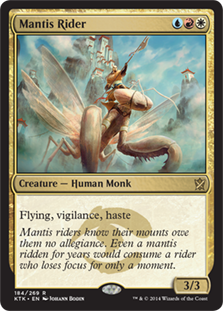 Haste, the most gamebreaking of the evergreen mechanics, gives Rider a sizable power boost. Say it stays on the battlefield for only one turn cycle after coming down. That's still two attacks; its power may as well have been six in this case. Three turns? May as well have been four. And in a turn four format, how often is the turn clock going to outrun the damage advance?
Haste, the most gamebreaking of the evergreen mechanics, gives Rider a sizable power boost. Say it stays on the battlefield for only one turn cycle after coming down. That's still two attacks; its power may as well have been six in this case. Three turns? May as well have been four. And in a turn four format, how often is the turn clock going to outrun the damage advance?
Then there's flying, grandfather of evasion keywords. Being able to out-muscle enemy beaters becomes less of a factor when Rider just soars over them. And vigilance, which lets pilots essentially double up on Riders—with "one" attacking and "one" blocking, that three mana ends up buying twice as much power and toughness as advertised.
Castability: 3
Rider is mostly played in Humans, a deck capable of pumping it out on turn two should Noble Hierarch live. If the dork dies, though, Rider becomes a top-end threat for the deck, and one they might not have time to cast against the format's faster decks. This volatility speaks to Humans's dependance on its opener and on enemy options not lining up correctly, and plants Rider firmly in the middle of the metric.
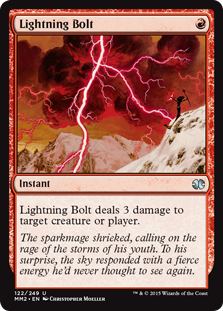 Resilience: 2
Resilience: 2
All the removal spells kill Mantis Rider, including Lightning Bolt. But against Humans, that Bolt may have been spent on Champion, Hierarch, or Thalia by the time the 3/3 resolves. To its credit, Rider enjoys total immunity to graveyard hate and hosers like Chalice of the Void; in this metagame, Leyline of the Void in fact sees more play than the red instant.
Overall: 8
#4: Tarmogoyf
Bulk: 3
4/5 really ain't what it used to be. These days, the only decks running Goyf count on the beater as 3/4 or 4/5 in the early game, and plan on growing it to around 5/6 later on. The Lhurgoyf indeed boasts the potential to grow much larger, but if your deck is going to be built around a beater, better make it one of the higher-reward creatures listed below. Rather, Goyf shines alongside a core packed with disruption and in lieu of more effective attacking options. When a deck is stuffed to the gills with ways to tell the opponent "no," it simply can't accommodate the wealth of enablers required by Modern's more alluring combat creatures.
 Castability: 5
Castability: 5
Man, is Goyf ever castable. That's always been the case in Modern, when even utterly off-color decks like UR Twin would splash for the threat. Its cheap, color-light price tag is what keeps it at the top tables at all these days, now right at home in its favorite midrange deck, Jund. That strategy's otherwise color-intensive roster and high curve make Goyf a welcome draw at all stages of the game.
Resilience: 1
I never thought we'd see the day where Mantis Rider is tougher than Tarmogoyf, but here we are. Goyf was once feared in large part thanks to its resilience; graveyard hate was far less prevalent in Modern's early days, and we didn't have Fatal Push to check Goyf at a tempo gain. Push itself relegated Goyf to usage in just a few strategies, but the uptick in graveyard hate has also hurt the card—it's just incredibly fragile right now. No matter when Rest in Peace comes down, all Goyfs will be reduced to 0/1, be they in play, in hand, or in deck. That's untrue of other graveyard creatures, which may demand more resources to be cast, but reward pilots by sneering in the face of late hate once on the battlefield.
Overall: 9
#3: Thing in the Ice
Bulk: 4
Enter the big boys. At 7/8, Thing in the Ice possesses more raw size than any Modern staple this side of Horizons. Its transform ability also clears the battlefield for a first hit, dealing with would-be chump blockers and revenge killers.
Castability: 2
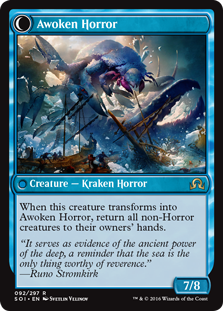 While 1U is supremely reasonable, sticking Awoken Horror is a bit harder than its casting cost might suggest. Thing requires four instants or sorceries to be cast before flipping, making it among the least "castable" beaters here—before transforming, after all, it's not so much a beater as a poor man's Wall of Omens.
While 1U is supremely reasonable, sticking Awoken Horror is a bit harder than its casting cost might suggest. Thing requires four instants or sorceries to be cast before flipping, making it among the least "castable" beaters here—before transforming, after all, it's not so much a beater as a poor man's Wall of Omens.
It's true that UR Phoenix, Thing's primary home, is more than capable of accommodating the 0/4 by turn three. But mulligans complicate this gameplan, as can extenuating game state circumstances. In many scenarios, that turn-three Thing is a lot easier to achieve than a turn-six one; without a stream of resources handy, Thing forces pilots to wait around until they've met its demands prior to turning sideways.
Resilience: 4
Fatal Push kills Thing, but Bolt doesn't. Sound familiar? Goyf's is a similar story on that front; Thing's big advantage over its green counterpart is a complete obliviousness to the graveyard. It's also very difficult to kill once Awoken, as swaths of damage-based removal are currently employed to remove buff creatures: Dismember and Lightning Axe, for instance, become useless in the face of a 7/8.
Overall: 10
#2: Reality Smasher
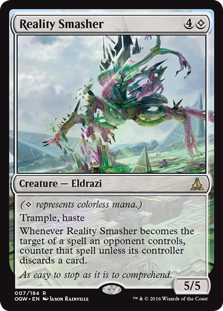 Bulk: 4
Bulk: 4
Joining thing at 4 bulk is Reality Smasher, who makes up for its smaller frame with evergreen mechanics. Haste puts its damage output above Thing's for the first three turns, and trample deals with chump blockers beyond the pivotal transformation turn. The broken Eldrazi deck of winters yore may well have still dominated without Reality Smasher, but this 5/5 nonetheless proved the face of the menace, in no small part thanks to its raw aggressive output. CRUNCH!
Castability: 2
Castability is where Smasher struggles. It doesn't require additional work like Thing, but five is a heck of a converted mana cost. The decks that employ Smasher tend to have Eldrazi Temple on hand, or simply assemble Tron with some accuracy, making Smasher closer to a four-drop.
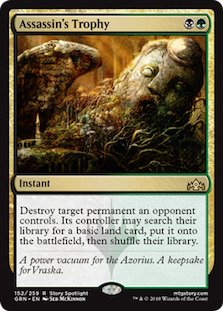 But that's still more mana spent than anything else on this list. Indeed, Smasher is the only Stage 3 combat creature here, signaling a momentous shift in Modern's power balance that we'll delve into in the next section.
But that's still more mana spent than anything else on this list. Indeed, Smasher is the only Stage 3 combat creature here, signaling a momentous shift in Modern's power balance that we'll delve into in the next section.
Resilience: 5
Leyline? Shrug. Fatal Push? lol. Assassin's Trophy? Congrats; enjoy your discard! Whatever your answer, Smasher probably just doesn't care. And if it does, opponents are forced to minus just to get it off the table. The exceptions are sweepers, a card type nigh-exclusive to UW Control, and larger-still bodies, which can be run over with Dismember.
Overall: 11
#1: Hogaak, Arisen Necropolis
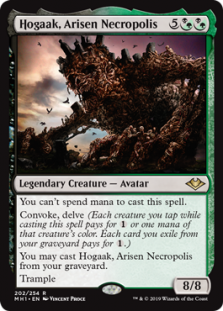 Bulk: 5
Bulk: 5
This is it: the final frontier. Nothing dwarfs Hogaak in Modern except for dangerous Death's Shadows. But even those don't have trample, a keyword that takes Hogaak from dumb to absurd; Shadow clings to red for Temur Battle Rage, while Hogaak has one built-in.
Castability: 4
Two black or green creatures in play and five cards in the graveyard. Steep casting conditions? Apparently not; Frank Karsten asserts that Hogaak can be cast on turn two in 60% of games, a feat eminently doable even on a mulligan to five. And who are we mortals to argue with the numbers?
The wizards behind the curtain are Stitcher's Supplier and Satyr Wayfinder, which turbo-charge the graveyard, provide bodies to convoke with, dig for additional bodies in the form of Bloodghast and Gravecrawler, and draw into Hogaak itself. These creatures ensure Hogaak's dominance, helping it come down with the speed of a Stage 2 combat creature despite boasting Stage 4 stats.
Resilience: 4
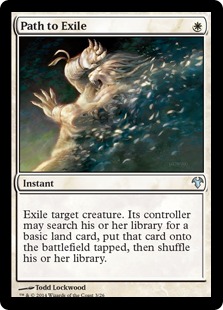 Before we touch on graveyard hate, let's consider Modern's other checks to fatties. Terminate, Assassin's Trophy, and the like take Hogaak off the table as they do Reality Smasher. But instead of making opponents discard, Hogaak does us one better: it comes right back to the battlefield! Removing Hogaak really means exiling it, but that's also a shaky plan; Path to Exile can be responded to with Carrion Feeder, sacrificing Hogaak for the Greater Good. In lieu of Feeder, exiling one Hogaak won't change the world, either; its namesake deck specializes in stuffing the graveyard full of convoking delvers, so there's likely to be another in tow.
Before we touch on graveyard hate, let's consider Modern's other checks to fatties. Terminate, Assassin's Trophy, and the like take Hogaak off the table as they do Reality Smasher. But instead of making opponents discard, Hogaak does us one better: it comes right back to the battlefield! Removing Hogaak really means exiling it, but that's also a shaky plan; Path to Exile can be responded to with Carrion Feeder, sacrificing Hogaak for the Greater Good. In lieu of Feeder, exiling one Hogaak won't change the world, either; its namesake deck specializes in stuffing the graveyard full of convoking delvers, so there's likely to be another in tow.
Which brings us to the elephant in the room: hosers, of which Modern stocks plenty. With either Leyline of the Void or Rest in Peace in play, Hogaak can never hit the battlefield. So why does the data indicate that packing these cards in spades does not add many, or any, percentage points against the infamous Avatar?
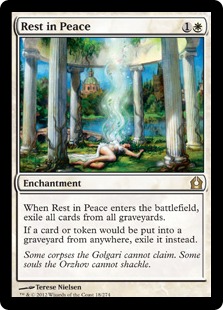 For one, Hogaak is ready for the hate. Its enablers are efficient enough, and the deck streamlined enough, that its pilots don't mind running more enchantment-removing cards than opponents could even have hateful enchantments. And they're all coming in, with little change to Hogaak's speed consistency.
For one, Hogaak is ready for the hate. Its enablers are efficient enough, and the deck streamlined enough, that its pilots don't mind running more enchantment-removing cards than opponents could even have hateful enchantments. And they're all coming in, with little change to Hogaak's speed consistency.
Second, the deck is too fast. Slamming Rest in Peace doesn't invalidate a Hogaak already on the battlefield, as with Tarmogoyf; the enchantment needs to be in play first. Except Rest in Peace pilots, even assuming they run four copies, don't play one- and two-mana creatures that cast functional Ancestral Recalls and Impulses upon resolution to look for that enchantment. In other words, Hogaak is far more likely to have Hogaak than anything else is to have Rest in Peace—or Leyline of the Void, actually fast enough to stop Hogaak, but also stringent enough to necessitate a copy in the opening hand. This option has been considered by some high-level (and tournament-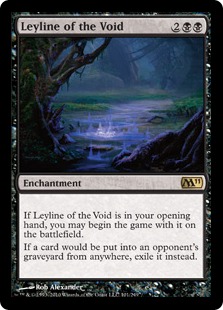 winning) players too unreliable to even employ.
winning) players too unreliable to even employ.
Then there are lower-tier grave-hate options, such as Tormod's Crypt, Ravenous Trap, and Relic of Progenitus. These speedbumps are of little import to Hogaak, which can go off without even removing them. My favorite of this bunch is Surgical Extraction, which can indeed prove gamebreaking when it successfully exiles the titular threat. But targeting Hogaak itself is no picnic, as pilots retain priority to cast the 8/8 after milling it; wary Hogaak players won't give opponents a window to use Surgical.
Overall: 13
Hard to Beat
All these factors combine to give Hogaak a score not just one, but two points higher than my #2 choice. Modern has become about beaters, but looking more closely, it seems to have become mostly about one in particular. Whether the deck's supposed volatility will end up checking it over the coming weeks remains to be seen, but color me skeptical. There are other players in this beater's game, but the deck seems stacked against them.


